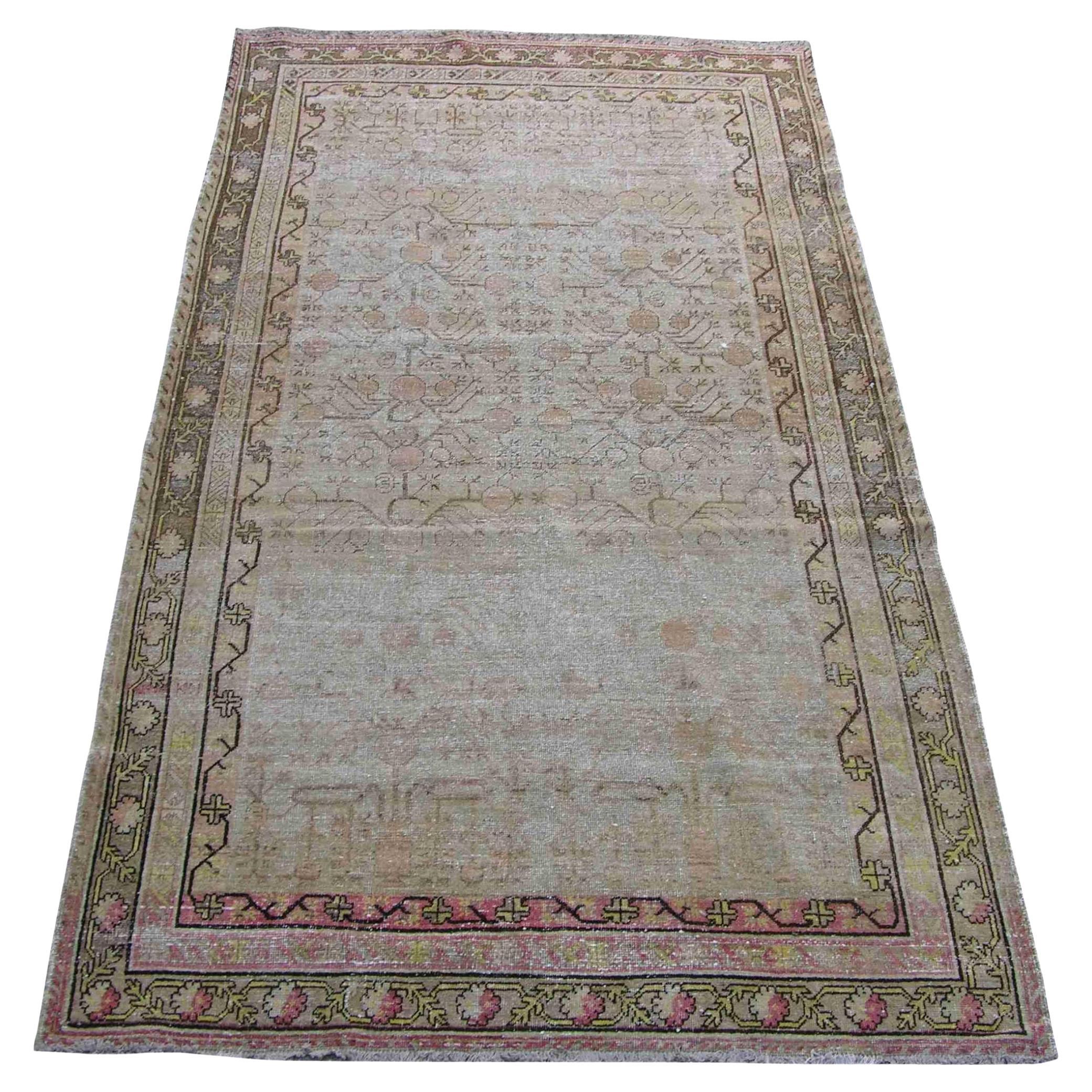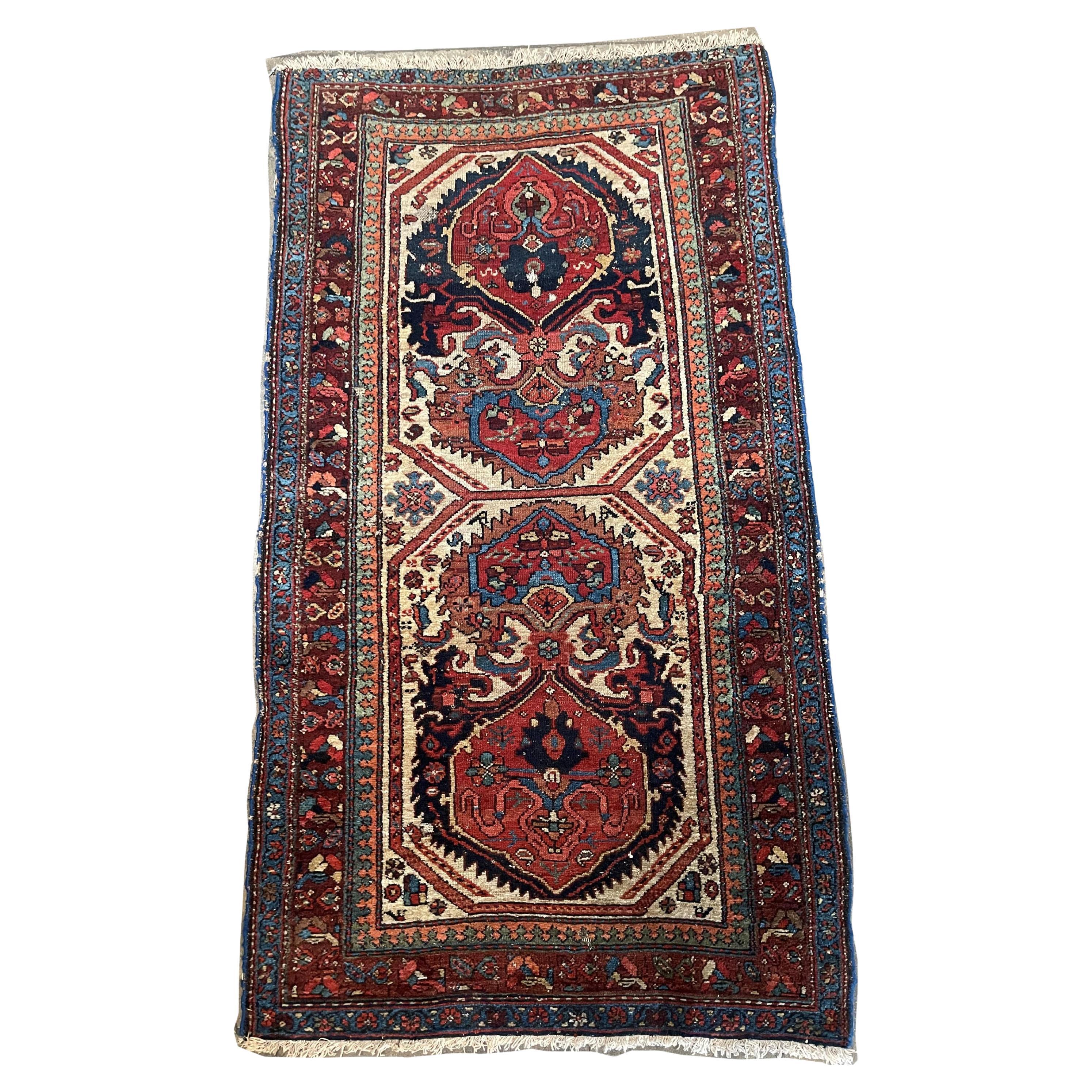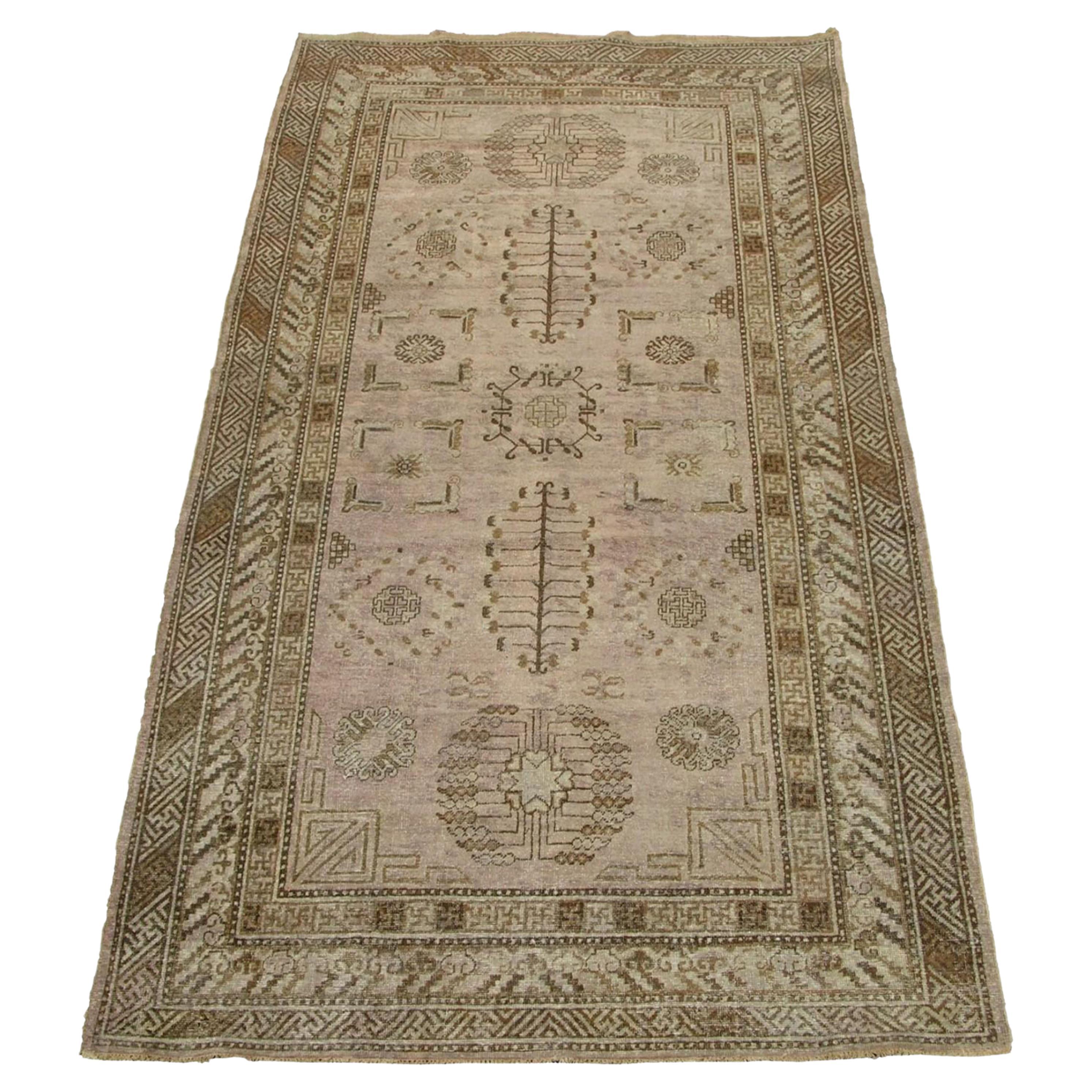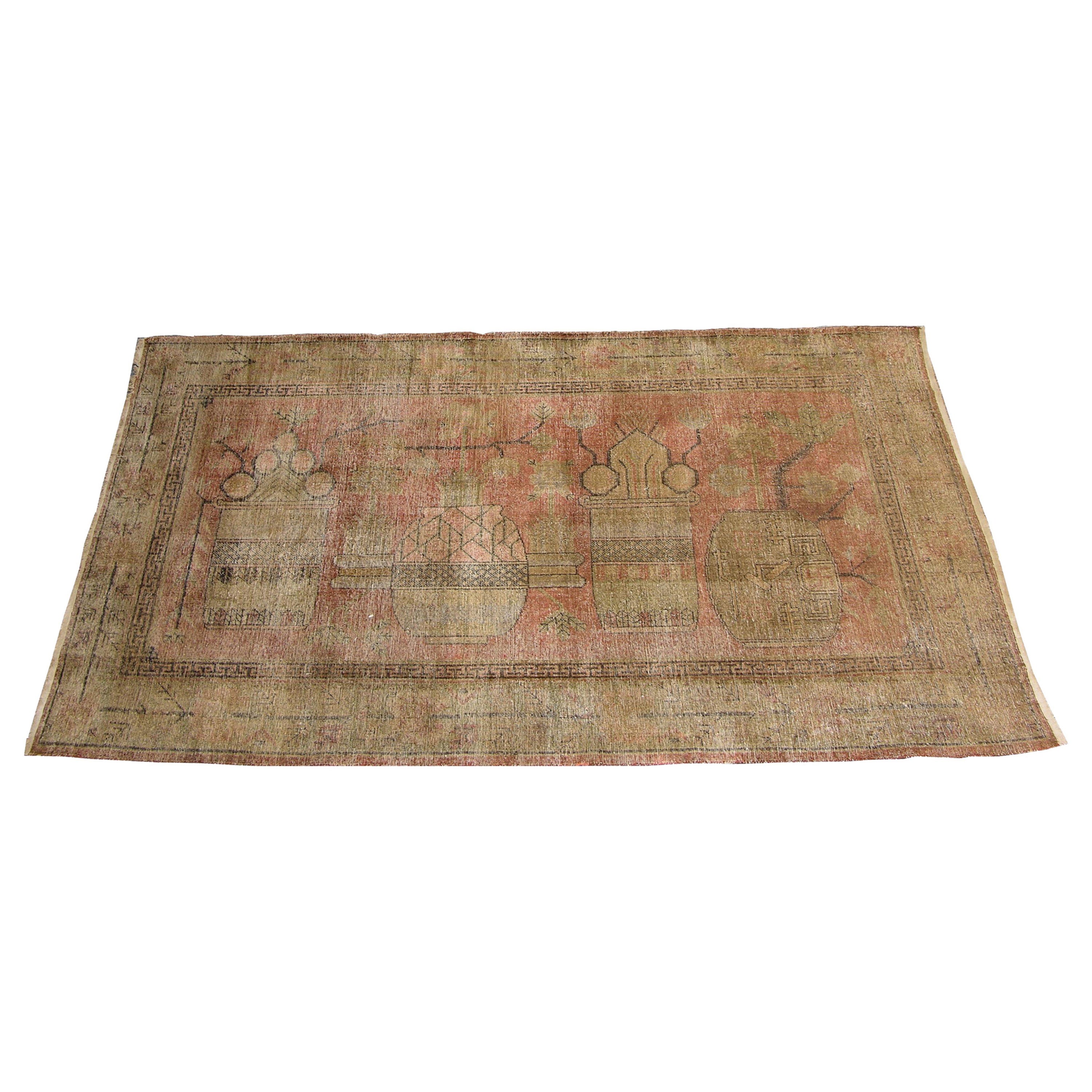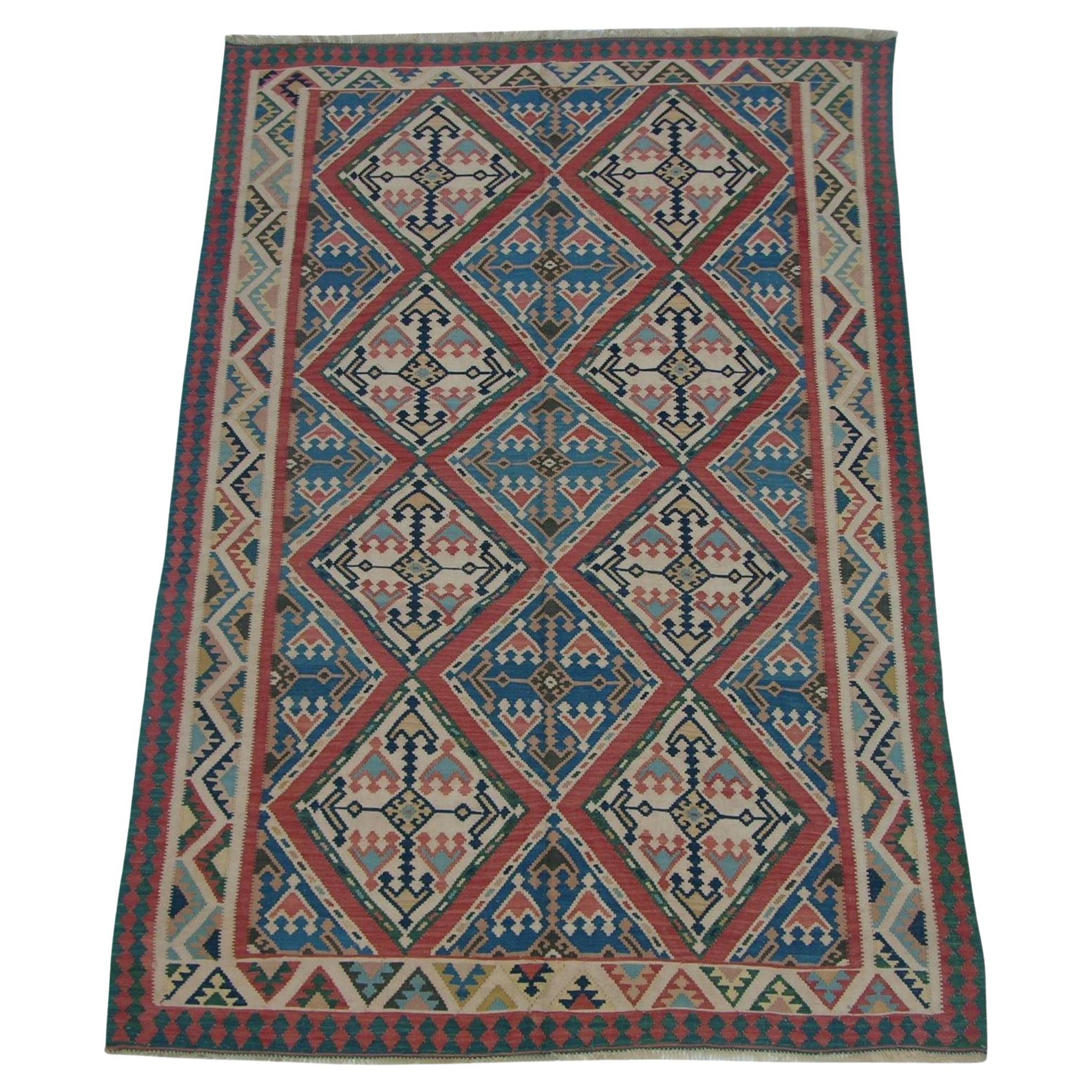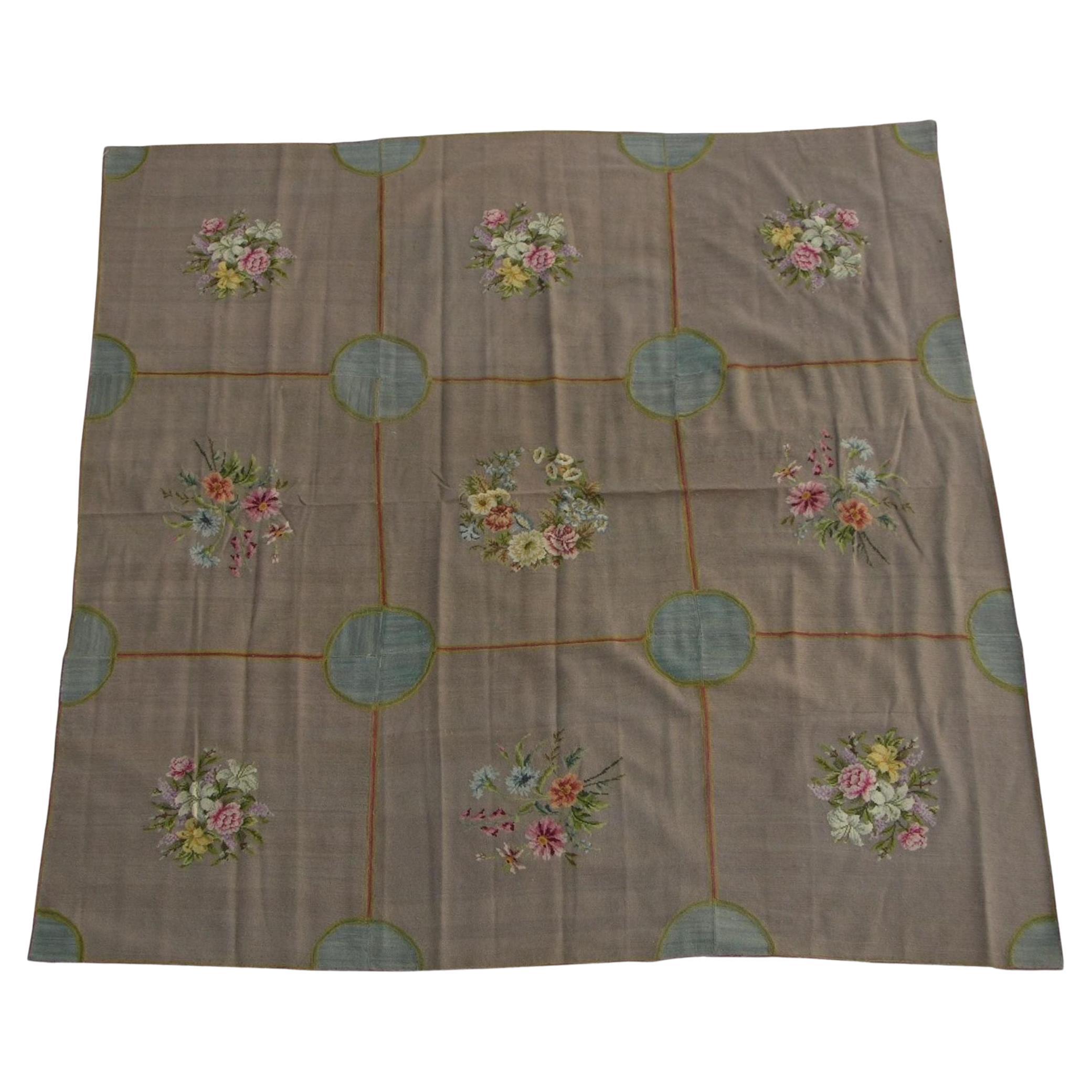Items Similar to 1920s Antique Patchwork Rug
Want more images or videos?
Request additional images or videos from the seller
1 of 5
1920s Antique Patchwork Rug
About the Item
Antique rugs that are called “Kilim rugs”, primarily refer to a type of flat weave rug that was produced without knotted pile. Because these antique rugs are found across the globe, each region has a different pronunciation and spelling of the name Kilim. Homers Iliad and Egyptian tomb paintings, from the same time period, depict weavers producing rugs and carpets of this kind.
Since this is one of the oldest methods of rug production, it is considered to be primitive compared to Oriental hand knotted rugs. Comprised of simple interlocking strands of wool, hair or fiber, Kilims are durable, decorative and used for many purposes. Some of these uses include, clothing, shelter, storage, floor coverings, pillows and barter / trade.
Once overlooked as utilitarian, low status items, antique Kilims are now prized as some of the most powerful and authentic weaving of the Middle East. Kilim rugs (Gilim in Persian) is a Turkish word denoting Caucasus made in simple flat-woven or tapestry technique, in which the pattern is produced entirely by horizontal wefts that cover the vertical warps.
This technique makes it very difficult to produce continuous vertical linear separations of color in the design, so Kilims often have a stepped or crenelated effect. While the weaving quality of kilims can be fine, they tend to rely more on large-scale patterns with striking drawing and effects of color. They may utilize allover designs or grand shield-like medallions.
The most well known Kilims are those of Turkey or Anatolia, which are varied in type and effect, but Caucasian and Persian Jajim and Kilim rugs are also appreciated nowadays for their color and high technical skill. Given their thinner, supple structure, Kilim rugs are usable not only as decorative floor covering, but also as wall hangings and on furniture or bed coverlets as well.
Originating in Anatolia and the Caucasus, flat woven kilims and tribal symbols gradually transitioned to pile rugs as nomadic and semi-nomadic herders ebbed back and forth across the continent. Traditions from turkey and the Levant traveled steadily eastward to the Mougal / Mughal states of Pakistan and India as well as Buddhist regions of Tibet, China and East Turkestan.
Kilim rugs are beautiful Middle Eastern masterpieces that denote pile-less textiles. Because these rugs do not feature that additional backing, they are often much thinner and easier to apply to walls as tapestries or on top of bare-bones flooring and other sections around the room. These rugs follow a specific flat-weaving technique that originated around Turkey, North Africa, Iran and Afghanistan. As these weaving techniques spread around the world, weavers from all over began to develop their own kilim rugs, incorporating their own traditional cultural elements through the use of this style of weaving.
kilims feature muted colors and thin textures to allow the picture itself to stand out as the most noticeable feature on the rug’s surface. Warm colors are often used as the primary hues throughout, though many kilims tend to balance the landscape by also applying cooler tones, which help create points of contrast that entice the viewer’s responsiveness. Classical Turkish motifs are also often used along the rug’s surface, with elements such as perennials, pomegranates and fronds featured heavily in both borders and centers. The flow of movement generally varies from rug to rug, though angular motions are used more often to establish a central degree of grounding. Decorating with kilims can be as simple as setting them alongside other muted elements to create a pleasant transition for the eyes.
Many kilims use sharply contrasting colors to stand out as centerpieces, but the muted tones are otherwise best applied as an accenting force, especially if there are brighter and more noticeable furnishings present in the room. Set kilims alongside furnishings or underneath functional pieces of furniture, such as tables and chairs, to allow the room’s dynamic to flow more elegantly, especially if there are neutral tones and lighter colors that can match the kilim’s degree of visibility.
- Dimensions:Width: 73 in (185.42 cm)Length: 75 in (190.5 cm)
- Style:Other (In the Style Of)
- Materials and Techniques:
- Place of Origin:
- Period:1900-1909
- Date of Manufacture:1900
- Condition:good condition.
- Seller Location:Los Angeles, US
- Reference Number:
About the Seller
5.0
Gold Seller
These expertly vetted sellers are highly rated and consistently exceed customer expectations.
Established in 1920
1stDibs seller since 2023
26 sales on 1stDibs
Typical response time: <1 hour
- ShippingRetrieving quote...Ships From: Los Angeles, US
- Return PolicyA return for this item may be initiated within 3 days of delivery.
More From This SellerView All
- 1920s Antique Hamedan RugLocated in Los Angeles, USShirvan rugs – The historic Khanate or administrative district of Shirvan produced many highly decorative antique rugs that have a formality and stylistic complexity that is found in...Category
Antique Early 1900s Asian Other Russian and Scandinavian Rugs
MaterialsWool, Cotton
- 1920s Antique Samarkand RugLocated in Los Angeles, USAntique Samarkand Rugs: The desert oasis of Khotan was an important stop on the Silk Road. The people of Khotan were expert carpet weavers who produced high quality antique rugs and ...Category
Vintage 1920s Other Russian and Scandinavian Rugs
MaterialsWool, Cotton
- 1920s Antique Samarkand RugLocated in Los Angeles, USAntique Samarkand Rugs: The desert oasis of Khotan was an important stop on the Silk Road. The people of Khotan were expert carpet weavers who produced high quality antique rugs and ...Category
Vintage 1920s Other Russian and Scandinavian Rugs
MaterialsWool, Cotton
- 1920s Antique Floral Samarkand RugLocated in Los Angeles, USAntique Samarkand Rugs: The desert oasis of Khotan was an important stop on the Silk Road. The people of Khotan were expert carpet weavers who produced high quality antique rugs and ...Category
Vintage 1920s Other Russian and Scandinavian Rugs
MaterialsWool, Cotton
- 1920s Antique Swedish Kilim RugLocated in Los Angeles, USAntique rugs that are called “Kilim rugs”, primarily refer to a type of flat weave rug that was produced without knotted pile. Because these antique rugs are found across the globe, ...Category
Antique Early 1900s Asian Other Russian and Scandinavian Rugs
MaterialsWool, Cotton
- 1920s Antique Needlepoint Rug - 6'7'' X 6'5''Located in Los Angeles, USNeedlepoint rugs were created using the traditional needlework weaving technique that is used to make everyday items from furniture to carpets and artwork. However, it has a fascinating history both as a hobby and as an industry. When many people think of carpets, they think of pile carpets or flat weave kilims, but needlepoint has also been used to create beautiful carpets. These carpets are durable and an important part of carpet history. Archaeologists and scholars consider the roots of needlepoint to have been around 1500 BC. They consider the first needlepoint to include the fine diagonal stitches that were used to sew tents together by the ancient Egyptians. The art eventually evolved into tapestry weaving. However, a tapestry weaving differs significantly from needlepoint in that it uses a loom and vertical warp. Tapestry weaving is closer to the weaving of kilims and pile rugs than canvas work. However, some still include tapestry weaving in the category of needlepoint because of the fine work that appeared during the late Renaissance. It can have a similar appearance to the untrained eye. Technically, tapestry weaving and needlepoint are not the same, and they do not use the same technique. The first actual needlepoint rugs and needle-points began to appear in the late Renaissance. Needlepoint is worked by creating stitches on a stiff canvas. The canvas is typically made from jute or linen and is quite durable. Pieces from the Renaissance were used to cover footstools, chairs, pillows, bed headboards, and other furnishings. They were also used as table coverings and wall coverings. You could also find them on many small items such as purses, shoes, and various adornments for clothing. During the Renaissance, the craft reached a high level of skill, and the designs became incredibly detailed and realistic. They mimicked many of the subjects and styles of famous paintings of the time. They created florals, still life designs, scenes, and geometric tiled pieces. Some of them mimicked the designs found in Persian Carpets. Needlepoint reached its peak popularity in the 19th century when it was considered a proper occupation for a lady. Needlepoint and embroidery held a similar place in societal status at the time. During this time, the work became finer, with some of the canvas reaching a high level of detail. The level of detail is determined by counting the number of mesh in an inch. During this time petit point by French needlewomen could have a mesh count as high as 45 mesh. This allowed women to create highly intricate designs with incredible levels of detail. It is possible to find many antique pieces of needlepoint besides rugs. Needlepoint rugs were popular in France and Spain, where the technique was adapted to create highly intricate designs that mimicked the designs in architecture and fashion. They were popular because they were durable, and it could be fashioned into a variety of items. The canvases themselves were durable, and the wool that they used was also strong, which means that many of the pieces were able to withstand daily use. We have many artifacts that have survived from this time period. Needlepoint rugs are important collectibles because they are different from the pile rugs and kilims that are typically found on the market. Needlepoint carpets are special because they take many hours to create, especially larger works. Needlepoint pieces of any type became popular throughout Europe during the 19th century. It is still a popular hobby today, but perhaps one of the most interesting stories is that of the Portuguese needlewomen of Arraiolos. The story of these women and their beautiful carpets begins in 1492. Needlepoint was a popular occupation in Spain, which had a large population of Moors and Jews. They were an integral part of Spanish culture. However, in 1492, Queen Isabella of Spain issued a proclamation that gave these ethnic groups the order to pack their bags and board ships headed...Category
Vintage 1920s Other Russian and Scandinavian Rugs
MaterialsWool
You May Also Like
- Bessarabian Kilim Rug, c.1920sLocated in Savannah, GAA Bessarabian Kilim rug, circa 1920s. 76 by 117 inchesCategory
Vintage 1920s Moldovan Other Russian and Scandinavian Rugs
MaterialsWool
- Antique Russian Tekke Turkman Rug from 1920sLocated in New York, NYAntique Russian Tekke Turkman rug from 1920s ( 3' 6" x 6' - 106 x 182 cm).Category
Antique Early 1900s Russian Russian and Scandinavian Rugs
MaterialsWool
- Hamadan Vintage Olive Green Rug Circa 1920sLocated in New York, NYOverwashed, modern aesthetic, faded olive Hamadan rug (Persian) with beautiful allover fieldCategory
Early 20th Century Russian and Scandinavian Rugs
MaterialsWool
- Striking Bessarabian Kilim, c. 1920sLocated in London, GBThe tradition of Bessarabian kilim weaving dates to the later period of Ottoman rule over the Eastern Balkans – broadly, the territory now covered by Bulgaria and Moldova – and is kn...Category
Vintage 1920s Balkan Bessarabian Russian and Scandinavian Rugs
MaterialsWool
- Rya Rug Swedish , 1920-1950Located in Ferrara, ITThis is a semi-antique Swedish “Rya” rug woven circa 1920 - 1950 and measures 228 x 170 CM in size. Its all-over field design is comprised of nine columns of repeating ellipse-shaped...Category
Mid-20th Century Swedish Other Russian and Scandinavian Rugs
MaterialsWool
- Impi Sotavalta Finnish Hand-Woven Lavender and Marigold Geometric Ray Rug, 1920sBy Kiikan Kotomo, Impi SoltavataLocated in Brooklyn, NYImpi Sotavalta (1885-1943) Finnish hand-woven wool lavender and marigold geometric ray rug, c. 1928, Finland. Gorgeous thick pile. Rare, divine color co...Category
Vintage 1920s Finnish Scandinavian Modern Western European Rugs
MaterialsWool
